Abstract
Background
Contract manufacturing of prescription drugs is perceived to be on the rise, as companies look to optimize manufacturing capacity by either outsourcing or manufacturing for others. The lack of transparency into these proprietary arrangements has led to concerns that outsourcing may result in an overly concentrated manufacturing base, making the system more vulnerable to drug shortages.
Methods
Using nonpublic, internal FDA data, we link 374 sterile injectable new drug applications (NDAs) and 797 abbreviated new drug applications (ANDAs, otherwise known as generics) with finished dosage form manufacturing facilities in which the drugs were made as of November 2014. We then examine which kinds of firms were outsourcing which products and for whom.
Results
We find that NDAs were twice as likely to be outsourced as ANDAs: 39% versus 19%. Outsourced NDAs were just as likely to be made in the US as in Western Europe (45%), but outsourced ANDAs were mostly made in Asia (57%). Large application holders outsourced 10% of their application portfolio. They also manufactured for others—about 14% of applications they made were for others. Sixty-one percent of contract manufacturing firms were small and of those, 76% owned no applications. Because so much contract manufacturing of sterile injectables was being done by small players, there were no discernable differences in market concentration measures between application holders and drug manufacturers.
Conclusion
The landscape of sterile injectable contract manufacturing in 2014 was diverse, with small and large companies participating. This diversity resulted in a market similar in its concentration on the ownership and manufacturing sides.
Similar content being viewed by others
References
News: Global pharmaceutical contract manufacturing market to reach US$40.7 billion by 2015. Pharmaceutical Manufacturing. http://www.pharmamanufacturing.com/industrynews/2011/004/. Published 2011.
Wright T. 2015 outsourcing survey. Contract pharma for pharmaceutical & biopharmaceutical contract services & outsourcing. http://www.contractpharma.com/contents/view_outsourcing-survey/2015-05-13/2015-annual-outsourcing-survey/. Published 2015.
Conti RM, Berndt ER. Who makes this drug? http://www.fda.gov/downloads/ForIndustry/UserFees/GenericDrugUserFees/UCM451403.pdf. Published 2015.
Macher JT, Nickerson JA. Pharmaceutical manufacturing research project—final benchmarking report. McDonough School of Business, Georgetown University; 09/2006.
Conti RM. Who makes this drug? The rise of outsourcing pharmaceutical contract manufacturing. Cancer Lett. 2014;40:14.
Woodcock J, Wosinska M. Economic and technological drivers of generic sterile injectable drug shortages. Clin Pharmacol Ther. 2013;93:170–176.
US Food and Drug Administration. Drug Registration and Listing System (DRLS and eDRLS). https://www.fda.gov/Drugs/GuidanceComplianceRegulatoryInformation/DrugRegistrationandListing/ucm2007058.htm. Published 2012. Accessed September 23, 2015.
Smirnov NV. Estimate of deviation between empirical distribution functions in two independent samples. Bull Moscow Univ. 1939;2.
Kweder SL, Dill S. Drug shortages: the cycle of quantity and quality. Clin Pharmacol Ther. 2013;93:245–251.
Jensen V, Rappaport BA. The reality of drug shortages—the case of the injectable agent propofol. N Engl J Med. 2010;363:806–807.
Festel G, De Nard M, Simmen T. Outsourcing of pharmaceutical manufacturing—a strategic partner selection process. J Bus Chem. 2014;11:117–132.
Haninger K, Jessup A, Koehler K. Economic Analysis of the Causes of Drug Shortages. Washington, DC: Assistant Secretary for Planning and Evaluation, US Department of Health and Human Services; 2011.
Harris G. Medicines made in India set off safety worries. New York Times. February 15, 2015.
US Food and Drug Administration. Pathway to global product safety and quality. July 7, 2011.
Gray JV, Tomlin B, Roth AV. Outsourcing to a powerful contract manufacturer: The effect of learning-by-doing. Prod Oper Manag. 2009;18:487–505.
Author information
Authors and Affiliations
Corresponding author
Rights and permissions
About this article
Cite this article
Liu, W., Wosinska, M.E. The Landscape of Contract Manufacturing of Sterile Injectable Drugs: Who Is Making What, Where, and for Whom. Ther Innov Regul Sci 51, 471–479 (2017). https://doi.org/10.1177/2168479017696269
Published:
Issue Date:
DOI: https://doi.org/10.1177/2168479017696269




